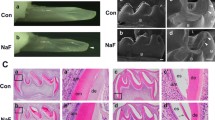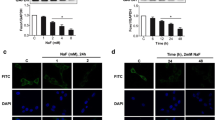Abstract
Decreased expression and increased phosphorylation of Forkhead box o1 (Foxo1) in ameloblasts were observed both in vivo and in vitro when treated by fluoride. The present study aims to investigate the possible relationship between Foxo1 and enamel matrix proteinases, matrix metalloproteinase 20 (MMP20), and kallikrein 4 (KLK4), in NaF-treated ameloblasts. Ameloblast-like cells (LS8 cells) were exposed to NaF at selected concentration (0/2 mM) for 24 h. Gene overexpression and silencing experiments were used to up- and down-regulate Foxo1 expression. The expression levels of Foxo1, MMP20, and KLK4 were detected by quantitative real-time PCR and western blot. Dual luciferase reporter assay was performed to evaluate the regulation of Foxo1 on the transcriptional activity of KLK4 promoter. The results showed that KLK4 expression was decreased in LS8 cells treated by NaF, while MMP20 expression was not changed. Foxo1 activation led to significantly up-regulation of KLK4 in LS8 cells under NaF condition. Knockout of Foxo1 markedly decreased klk4 expression in mRNA level, and intensified inhibition occurred in LS8 cells when combined with NaF treatment. However, the variation trend of MMP20 was not clear. Dual luciferase reporter assay showed that Foxo1 activation enhanced the transcriptional activity of KLK4 promoter. These findings suggest that the decrease of Foxo1 expression induced by high fluoride was a cause for low KLK4 expression.




Similar content being viewed by others
References
Health USDo, Human Services Federal Panel on Community Water F (2015) U.S. Public Health Service recommendation for fluoride concentration in drinking water for the prevention of dental caries. Public Health Rep 130(4):318–331. https://doi.org/10.1177/003335491513000408
Clark MB, Slayton RL, Section on oral H (2014) Fluoride use in caries prevention in the primary care setting. Pediatrics 134(3):626–633. https://doi.org/10.1542/peds.2014-1699
Nair R, Chuang JC, Lee PS, Leo SJ, Yang NQ, Yee R, Tong HJ (2016) Adult perceptions of dental fluorosis and select dental conditions—an Asian perspective. Community Dent Oral Epidemiol 44(2):135–144. https://doi.org/10.1111/cdoe.12197
Barbier O, Arreola-Mendoza L, Del Razo LM (2010) Molecular mechanisms of fluoride toxicity. Chem Biol Interact 188(2):319–333. https://doi.org/10.1016/j.cbi.2010.07.011
Agalakova NI, Gusev GP (2012) Molecular mechanisms of cytotoxicity and apoptosis induced by inorganic fluoride. ISRN Cell Biol 2012:1–16. https://doi.org/10.5402/2012/403835
Wahluyo S, Ismiyatin K, Purwanto B, Mukono IS (2017) The influence of sodium fluoride on the growth of ameloblasts and kidney proximal tubular cells. Folia Biol (Praha) 63(1):31–34
Denbesten P, Li W (2011) Chronic fluoride toxicity: dental fluorosis. Monogr Oral Sci 22:81–96. https://doi.org/10.1159/000327028
Suzuki M, Shin M, Simmer JP, Bartlett JD (2014) Fluoride affects enamel protein content via TGF-beta1-mediated KLK4 inhibition. J Dent Res 93(10):1022–1027. https://doi.org/10.1177/0022034514545629
DenBesten PK, Zhu L, Li W, Tanimoto K, Liu H, Witkowska HE (2011) Fluoride incorporation into apatite crystals delays amelogenin hydrolysis. Eur J Oral Sci 119(Suppl 1):3–7. https://doi.org/10.1111/j.1600-0722.2011.00903.x
Wei W, Gao Y, Wang C, Zhao L, Sun D (2013) Excessive fluoride induces endoplasmic reticulum stress and interferes enamel proteinases secretion. Environ Toxicol 28(6):332–341. https://doi.org/10.1002/tox.20724
Le MH, Nakano Y, Abduweli Uyghurturk D, Zhu L, Den Besten PK (2017) Fluoride alters Klk4 expression in maturation ameloblasts through androgen and progesterone receptor signaling. Front Physiol 8:925. https://doi.org/10.3389/fphys.2017.00925
Sharma R, Tsuchiya M, Skobe Z, Tannous BA, Bartlett JD (2010) The acid test of fluoride: how pH modulates toxicity. PLoS One 5(5):e10895. https://doi.org/10.1371/journal.pone.0010895
DenBesten PK, Yan Y, Featherstone JD, Hilton JF, Smith CE, Li W (2002) Effects of fluoride on rat dental enamel matrix proteinases. Arch Oral Biol 47(11):763–770
Zhang Y, Yan Q, Li W, DenBesten PK (2006) Fluoride down-regulates the expression of matrix metalloproteinase-20 in human fetal tooth ameloblast-lineage cells in vitro. Eur J Oral Sci 114(Suppl 1):105–110; discussion 127–109, 380. https://doi.org/10.1111/j.1600-0722.2006.00303.x
Sharma R, Tye CE, Arun A, MacDonald D, Chatterjee A, Abrazinski T, Everett ET, Whitford GM, Bartlett JD (2011) Assessment of dental fluorosis in Mmp20 +/- mice. J Dent Res 90(6):788–792. https://doi.org/10.1177/0022034511398868
Inoue T, Shinnakasu R, Ise W, Kawai C, Egawa T, Kurosaki T (2017) The transcription factor Foxo1 controls germinal center B cell proliferation in response to T cell help. J Exp Med 214(4):1181–1198. https://doi.org/10.1084/jem.20161263
Li Y, Ma Z, Jiang S, Hu W, Li T, Di S, Wang D, Yang Y (2017) A global perspective on FOXO1 in lipid metabolism and lipid-related diseases. Prog Lipid Res 66:42–49. https://doi.org/10.1016/j.plipres.2017.04.002
Han J, Jin R, Zhang M, Guo Q, Zhou F (2017) Ikaros 6 protects acute lymphoblastic leukemia cells against daunorubicin-induced apoptosis by activating the Akt-FoxO1 pathway. J Leukoc Biol 101(3):675–681. https://doi.org/10.1189/jlb.2A0116-040RR
Ochodnicka-Mackovicova K, Bahjat M, Maas C, van der Veen A, Bloedjes TA, de Bruin AM, van Andel H, Schrader CE, Hendriks RW, Verhoeyen E, Bende RJ, van Noesel CJ, Guikema JE (2016) The DNA damage response regulates RAG1/2 expression in pre-B cells through ATM-FOXO1 signaling. J Immunol 197(7):2918–2929. https://doi.org/10.4049/jimmunol.1501989
Poche RA, Sharma R, Garcia MD, Wada AM, Nolte MJ, Udan RS, Paik JH, DePinho RA, Bartlett JD, Dickinson ME (2012) Transcription factor FoxO1 is essential for enamel biomineralization. PLoS One 7(1):e30357. https://doi.org/10.1371/journal.pone.0030357
Gao J, Ruan J, Gao L (2014) Excessive fluoride reduces Foxo1 expression in dental epithelial cells of the rat incisor. Eur J Oral Sci 122(5):317–323. https://doi.org/10.1111/eos.12148
Li J, Zhao L, Zhao X, Wang P, Liu Y, Ruan J (2017) Foxo1 attenuates NaF-induced apoptosis of LS8 cells through the JNK and mitochondrial pathways. Biol Trace Elem Res 181:104–111. https://doi.org/10.1007/s12011-017-1015-1
Pfaffl MW (2001) A new mathematical model for relative quantification in real-time RT-PCR. Nucleic Acids Res 29(9):e45
Marin LM, Cury JA, Tenuta LM, Castellanos JE, Martignon S (2016) Higher fluorosis severity makes enamel less resistant to demineralization. Caries Res 50(4):407–413. https://doi.org/10.1159/000447270
Martinez-Mier EA, Shone DB, Buckley CM, Ando M, Lippert F, Soto-Rojas AE (2016) Relationship between enamel fluorosis severity and fluoride content. J Dent 46:42–46. https://doi.org/10.1016/j.jdent.2016.01.007
Lyaruu DM, Medina JF, Sarvide S, Bervoets TJ, Everts V, Denbesten P, Smith CE, Bronckers AL (2014) Barrier formation: potential molecular mechanism of enamel fluorosis. J Dent Res 93(1):96–102. https://doi.org/10.1177/0022034513510944
Zhang Y, Kim JY, Horst O, Nakano Y, Zhu L, Radlanski RJ, Ho S, Den Besten PK (2014) Fluorosed mouse ameloblasts have increased SATB1 retention and Galphaq activity. PLoS One 9(8):e103994. https://doi.org/10.1371/journal.pone.0103994
Priyadharsini N, Malathi N, Tamizhchelvan H, Dineshkumar T (2015) Dental fluorosis: a histological study using light and confocal microscopy. Indian J Dent Res 26(3):248–251. https://doi.org/10.4103/0970-9290.162896
Bronckers AL, Lyaruu DM, DenBesten PK (2009) The impact of fluoride on ameloblasts and the mechanisms of enamel fluorosis. J Dent Res 88(10):877–893. https://doi.org/10.1177/0022034509343280
Everett ET (2011) Fluoride’s effects on the formation of teeth and bones, and the influence of genetics. J Dent Res 90(5):552–560. https://doi.org/10.1177/0022034510384626
Tanimoto K, Le T, Zhu L, Chen J, Featherstone JD, Li W, DenBesten P (2008) Effects of fluoride on the interactions between amelogenin and apatite crystals. J Dent Res 87(1):39–44
Duan X, Mao Y, Wen X, Yang T, Xue Y (2011) Excess fluoride interferes with chloride-channel-dependent endocytosis in ameloblasts. J Dent Res 90(2):175–180. https://doi.org/10.1177/0022034510385687
Sierant ML, Bartlett JD (2012) Stress response pathways in ameloblasts: implications for amelogenesis and dental fluorosis. Cell 1(3):631–645. https://doi.org/10.3390/cells1030631
Bartlett JD (2013) Dental enamel development: proteinases and their enamel matrix substrates. ISRN Dent 2013:684607. https://doi.org/10.1155/2013/684607
Bartlett JD, Simmer JP (2014) Kallikrein-related peptidase-4 (KLK4): role in enamel formation and revelations from ablated mice. Front Physiol 5:240. https://doi.org/10.3389/fphys.2014.00240
Seymen F, Park JC, Lee KE, Lee HK, Lee DS, Koruyucu M, Gencay K, Bayram M, Tuna EB, Lee ZH, Kim YJ, Kim JW (2015) Novel MMP20 and KLK4 mutations in amelogenesis imperfecta. J Dent Res 94(8):1063–1069. https://doi.org/10.1177/0022034515590569
Lee J, Yang G, Kim YJ, Tran QH, Choe W, Kang I, Kim SS, Ha J (2017) Hydrogen-rich medium protects mouse embryonic fibroblasts from oxidative stress by activating LKB1-AMPK-FoxO1 signal pathway. Biochem Biophys Res Commun 491(3):733–739. https://doi.org/10.1016/j.bbrc.2017.07.119
Zhang L, Tschumi BO, Lopez-Mejia IC, Oberle SG, Meyer M, Samson G, Ruegg MA, Hall MN, Fajas L, Zehn D, Mach JP, Donda A, Romero P (2016) Mammalian target of rapamycin complex 2 controls CD8 T cell memory differentiation in a Foxo1-dependent manner. Cell Rep 14(5):1206–1217. https://doi.org/10.1016/j.celrep.2015.12.095
Sin TK, Yung BY, Siu PM (2015) Modulation of SIRT1-Foxo1 signaling axis by resveratrol: implications in skeletal muscle aging and insulin resistance. Cell Physiol Biochem 35(2):541–552. https://doi.org/10.1159/000369718
Acknowledgments
We thank Professor Malcolm L. Snead (Department of Biomedical Sciences, University of Southern California) for donation of LS8 cells.
Funding
This study was funded by the National Natural Science Foundation of China (Grant No. 81470034).
Author information
Authors and Affiliations
Corresponding author
Ethics declarations
Conflict of Interest
The authors declare that they have no competing interests.
Rights and permissions
About this article
Cite this article
Li, J., Wang, P., Gao, J. et al. NaF Reduces KLK4 Gene Expression by Decreasing Foxo1 in LS8 Cells. Biol Trace Elem Res 186, 498–504 (2018). https://doi.org/10.1007/s12011-018-1325-y
Received:
Accepted:
Published:
Issue Date:
DOI: https://doi.org/10.1007/s12011-018-1325-y




